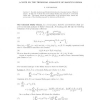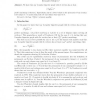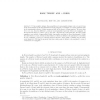JCT
1998
15 years 11 days ago
1998
Recently, Andrews and Berkovich introduced a trinomial version of Bailey’s lemma. In this note we show that each ordinary Bailey pair gives rise to a trinomial Bailey pair. This ...
100
Voted
JCT
1998
15 years 11 days ago
1998
We show that any k-regular bipartite graph with 2n vertices has at least ((k−1)k−1 kk−2 )n perfect matchings (1-factors). Equivalently, this is a lower bound on the permanent...
114
Voted
JCT
1998
15 years 11 days ago
1998
Let Q(N) denote the number of partitions of N into distinct parts. If ω(k) := 3k2 +k 2 , then it is well known that Q(N) + ∞X k=1 (−1)k “ Q(N − 2ω(k)) + Q(N − 2ω(−k)...
JCT
1998
15 years 11 days ago
1998
JCT
1998
15 years 11 days ago
1998
A conic of the Veronese surface in PG(5, 3) is a quadrangle. If one such quadrangle is replaced with its diagonal triangle, then one obtains a point model K for Witt’s 5–(12, ...
JCT
1998
15 years 11 days ago
1998
If t is a positive integer, then a partition of a non-negative integer n is a t−core if none of the hook numbers of the associated Ferrers-Young diagram is a multiple of t. These...
88
Voted
JCT
1998
15 years 11 days ago
1998
Given a tournament score sequence s1 ≥ s2 ≥ · · · ≥ sn, we prove that there exists a tournament T on vertex set {1, 2, . . . , n} such that the degree of any vertex i is ...
91
Voted
JCT
1998
15 years 11 days ago
1998
We introduce a concept of so-called disjoint ordering for any collection of finite sets. It can be viewed as a generalization of a system of distinctive representatives for the s...
JCT
1998
15 years 11 days ago
1998
JCT
1998
15 years 11 days ago
1998




